There are few companies in the world that have such a profound impact and reputation within their respective industries and Blizzard Entertainment.
While they merged with Activision some time ago – and are once again an independent company – this is really a look in to the Activision/Blizzard side of things. Originally founded under the name Silicon & Synapse, Blizzard Entertainment has ben an icon in the gaming industry for over 20 years. Even from an outside perspective, it appears they have done this through their unbridled commitment to quality, design, and most importantly, fun.
Looking over the success of Blizzard Entertainment, one very interesting and prominent fact continues to poke its head out that really makes you want to dig down to heart of the company: Blizzard is primarily a PC developer. It can be argued that they got their start on consoles with beloved games like The Lost Vikings and Rock n’ Roll Racing the majority of their games are PC exclusive. To me, that makes their success story even more interesting. Many other game companies cast as wide a net as possible by releasing games on as many platforms as possible. This has lead to the success of many companies such as Electronic Arts, Ubisoft, and even Blizzard’s sister company Activision. How is it then that Blizzard Entertainment continues to thrive and be one of the most influential and iconic game developers of all time?
Let’s take a look at Blizzard’s current most popular titles: we have World of Warcraft, StarCraft 2, Diablo III, Heroes of the Storm, Hearthstone and their yet-to-be-released FPS Overwatch. Blizzard’s big secret is that they don’t try to reinvent the wheel, they try to make the best damn wheel that they can. None of the titles above are new genres, have particularly innovative mechanics or gameplay, and they even belong to highly saturated markets. It is an accomplishment for any company to be able to run that many successful titles at once, but to pump out hit after hit in such a wide array of genres is nothing short of incredible.
The next big question is how is Blizzard’s take on genres any different from that other developers who put time, money, and effort in to their games?
It short, it comes down to a few key elements of Blizzard’s design philosophy.
The first aspect is “fun,” which tends to be forgotten by many games today. If an idea isn’t fun it’s not worth doing. Overwatch is a great example of this as it was the only fun and working component of Blizzard’s next-gen First Person Shooter MMO, the now defunct “Project Titan.” It went from being a small thing you did in a much more grandiose game, in to one of the most hotly-anticipated new IPs in recent history. Overwatch, for anyone not aware, is a class-based multiplayer shooter akin to Team Fortress 2. It was announced at BlizzCON 2014 and is the first new IP from Blizzard since the release of the original StarCraft in 1998. Overwatch took the first-person and arena shooter concept and expanded upon it to the point where the matches have an ebb and flow and you are constantly trying to adjust to the ever changing meta. One moment you might be fighting a giant crazed gorilla with some sniper support and the next you could be fighting a team full of robots that can transform at will in to a static defense turret. Not only was Overwatch announced at BlizzCON 2014, it was also playable. This along with an announcement that a closed-beta test was on its way help start a fire under Overwatch that has had people talking about it ever since.
The second major tenant that they rely on is quality. I may be going after some low-hanging fruit here, but after the disaster that was 2014 in terms of unfinished or outright broken games (Assassin’s Creed Unity, Drive Club, The Crew, Watch Dogs, Halo: The Master Chief Collection, Dragon Age: Inquisition, and many more that year) goes to show shows how important this dedication to quality is. Blizzard is notorious for saying that something will be released when it is ready or Soon™. While there have been blunders on their end, such as the Diablo III launch, any World of Warcraft Expansion or the Hearthstone launch, despite these small hiccups all of these games are still played extensively.
Their final element of game design that really helps push them to the next level is how accessible the games are. Sure they may not be easy at times but all of the games do a great job at getting you invested and rewarding you for smart gameplay. Anyone can hop in to Hearthstone, StarCraft 2, or Diablo III and pay at a level that is comfortable and fun for them. One of the best examples of this is Diablo III; the game starts you out simply, giving you a single attack and some rudimentary gear. As you progress through the story and the levels you start earning more abilities and better gear. That’s pretty standard fare in the RPG space but Diablo III pushes that a bit further. As you level up even more you start unlicking augments to your abilities so they start to behave in different and more interesting ways. As you hammer through the storyline (made longer when you jump into the Adventure Mode) and when facing the harder difficulties for prospects of better loot, it leaves you constantly thinking about how to tweak your skills to get that small gain in survivability or damage and has you looking as skill combinations you never would have considered before.
The same can be said about StarCraft.
The game brings you with a pretty nice introduction as to how a Real Time Strategy game works and once you feel good enough to start playing games that are challenging you are constantly thinking about how you can tweak your build order or how you can execute a strategy just a little better next time.
TotalBiscuit -- a prominent voice in the PC gaming space on YouTube -- has repeatedly called Heroes of the Storm the “Mario Kart of MOBAs.” Mario Kart is not the deepest, most complex racing game on the market by far, especially when compared to games like FORZA or even Gran Turismo. What it is, however, is a very accessible, easy-to-learn-difficult-to-master, and immensely fun racing game that nearly anyone can hop in to and enjoy. Heroes of the Storm takes this same formula and puts it on a genre filled with overly-complex games like League of Legends and DOTA 2. By removing many of the barriers that people found overwhelming like gearing, complex talent choices, and individual leveling, Blizzard created a game where nearly anyone can jump in and quickly understand the core components behind a MOBA and have fun with their friends.
This philosophy appears to carry over to their other games as well. World of Warcraft, for example, makes getting in to an MMORPG simple and it does a great job of teaching you the basics and giving you the ability to play how you want but also generating plenty of content for the hardcore community. You may not have the best gear or rotation (said hardcore community will tell you, loudly, if you don’t!) but you’re still allowed to play and level however you wish. StarCraft 2 makes the RTS genre accessible by keeping the maps, armies, and unit count relatively small while still being one of the most competitive games on the planet, and yet, again, there’s a huge community that takes it so seriously, eSports exist specifically thanks to the game! Hearthstone takes card game mechanics and makes them simple yet very deep, and, again, tournaments are held specifically for this game. Diablo 3 is another fun romp through an Action RPG that lets you play how you want and play at whatever difficulty you want at every point in the game so anyone can continue to push themselves for that next piece of better loot.
Of course, this also leads to, what I think, is the central reason as to why Blizzard is so successful with such a small library of games; the gaming community at-large. World of Warcraft will always be one of my favorite games despite the fact I rarely ever play it anymore. The reason for this is all of the memories I’ve had with my friends on there. Many people can say the same about various Blizzard games. Their games foster this great community where it is easy to meet like-minded people to enjoy a game session with and create bonds and powerful memories that make you just want to play more Blizzard games.
In the end, you can’t have any of the above without the final ingredient to success: passion.
In an interview with Polygon, Dustin Browder let us in on what makes Blizzard tick: They take games that they love and they tweak the concepts and ideas to make it in to something that they can call their own. They don’t want to be just like everyone else so they take the ideas and concepts that are already working and put their own spin and polish on it and come out with some of the most fun and influential games that we have ever seen. Sure Hearthstone is just another card game (Magic the Gathering, Ascenion, Pokemon TCG), World of Warcraft is just another MMORPG (EverQuest, WIldstar, Guild Wars), and Heroes of the Storm is another MOBA (League of Legends, Smite, DOTA 2) yet it’s the spin and polish that Blizzard adds to these games that makes them so great and impactful.
These core tenants of game design have made Blizzard a force to truly be reckoned with and have turned them in to the industry giant that they are despite limited console releases. Their unwavering commitment to making their games great, fun, and accessible has led to them setting the standard in multiple genres across the industry. There have been many clones of their games, but the originals (admittedly, some clones of other games, themselves) hold a special place in gamer’s hearts for years to come.

